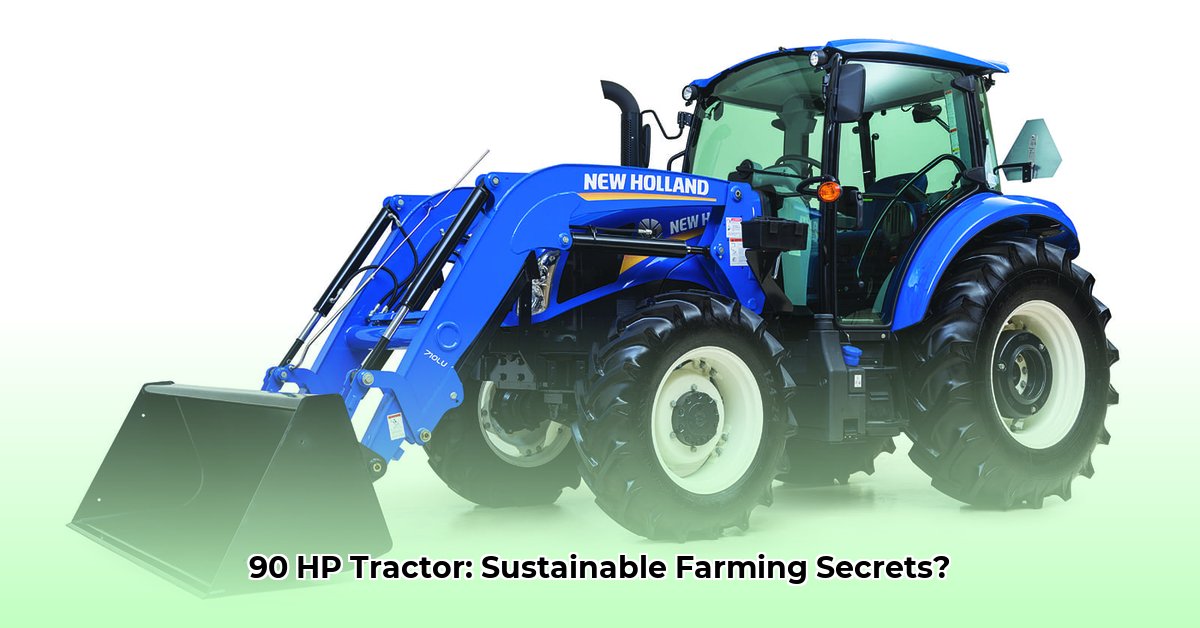
90 hp Tractor: A Deep Dive into Sustainable Farming Practices
Choosing the right tractor is a significant investment, impacting both your farm's productivity and its environmental footprint. The John Deere 5090E/M, a 90-horsepower utility tractor, presents itself as an option for sustainable agriculture, but a thorough examination is needed. This review analyzes its performance, sustainability features, usability, cost, and overall value, highlighting areas where more information is crucial for informed decision-making. For more on tractor drive types, see this helpful guide: 4WD vs 2WD.
Performance: Power Meets Efficiency—Or Does It?
The John Deere 5090E/M boasts 90 horsepower, sufficient for a wide range of farm tasks. However, a critical gap exists: detailed fuel efficiency data is scarce. While horsepower is a key spec, fuel consumption directly impacts both operational costs and environmental impact. Without precise fuel usage figures, a comprehensive comparison with competitors remains difficult. This lack of transparency hinders the evaluation of its true sustainability. Are you willing to invest in a tractor without knowing its long-term fuel consumption?
This situation highlights a broader issue: the need for greater transparency from agricultural equipment manufacturers regarding fuel efficiency metrics. This information is essential for farmers to make informed decisions that align with their sustainability goals.
Sustainability Features: Beyond Emissions Compliance
The John Deere 5090E/M meets FT4 emission standards, a positive step towards reducing greenhouse gas emissions. However, true sustainability extends beyond exhaust emissions. The tractor's lifecycle assessment— encompassing material sourcing, manufacturing processes, and end-of-life recyclability—remains largely undisclosed. How much of the tractor is made from recycled materials? What is its end-of-life recyclability rate? These questions remain unanswered.
Further research into the overall environmental impact, including material sourcing and recyclability, is vital. The current information only provides a partial picture of the tractor's environmental footprint.
Usability and Operator Experience: Comfort and Energy Consumption
The 5090E/M offers varied cab options: basic, standard, and premium (with climate control). While a comfortable cab enhances operator productivity and safety, the energy consumption of these different options remains unclear. A climate-controlled cab, for instance, may consume more fuel. This underscores the need for a comprehensive evaluation of how different cab configurations impact both operator well-being and the tractor's overall energy efficiency. Does the increased comfort of a premium cab offset the potential increase in fuel consumption?
Cost and Value: A Long-Term Perspective
The initial purchase price of the John Deere 5090E/M is a significant factor, but long-term operating costs are equally important. Due to a lack of precise fuel consumption data, estimating the total cost of ownership (TCO) is difficult. Without this pivotal piece of information, farmers can't accurately evaluate the tractor's overall value proposition over its lifespan. How will the tractor's fuel efficiency affect its long-term cost-effectiveness compared to other models?
Accurate fuel consumption data is critical for farmers to accurately project the long-term costs of running the tractor. This data, combined with maintenance and repair estimates, provides a much more precise total cost of ownership.
Overall Assessment: A Balanced Perspective
The John Deere 5090E/M offers considerable power and various comfort options, meeting important emission standards. Yet, a significant limitation is the lack of comprehensive data on fuel efficiency and lifecycle environmental impact. This data gap severely hinders a complete evaluation of its sustainability credentials.
Key Strengths:
- Meets FT4 emission standards.
- Offers various cab options for operator comfort.
- Provides sufficient power for various farm tasks.
Key Weaknesses:
- Lacks detailed fuel consumption data.
- Limited information on lifecycle environmental impact and recyclability.
- Difficulty in accurately assessing long-term operating costs.
Recommendation: While potentially a capable machine, farmers should strongly advocate for greater transparency from John Deere regarding fuel consumption and lifecycle assessment data before making a purchase decision. This information is crucial for evaluating the tractor's true sustainability and long-term cost-effectiveness. Decisions about farm equipment should be made on complete information.
Comparing the John Deere 5090E and 5090M: A Sustainability Focus
The John Deere 5090E and 5090M, while both 90 hp tractors, cater to different needs. The 5090E is built for robust, heavy-duty applications, while the 5090M might offer greater efficiency for lighter tasks. Comparing their sustainability remains challenging due to a consistent lack of detailed fuel consumption data. This absence makes a direct comparison of their environmental impact difficult.
Consider these factors:
- Workload: The 5090E's power is advantageous for heavy lifting; the 5090M may be more fuel-efficient for lighter applications.
- Fuel Efficiency: The lack of readily available fuel consumption data makes a comparison difficult. Direct inquiry to John Deere dealers is highly recommended.
- Maintenance: Factor in potential maintenance and repair differences between the models.
- Operator Comfort: Evaluate the impact of different cab options on efficiency and operator well-being.
- Budget: Consider both initial purchase price and projected operational costs, including fuel consumption.
Ultimately, the best option depends on individual farm needs and a thorough assessment weighing all these factors.